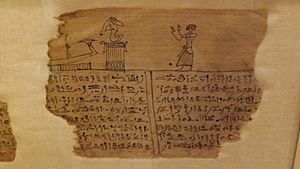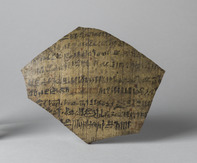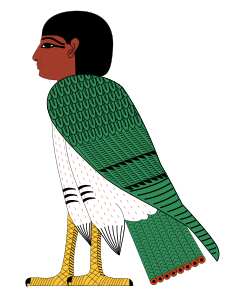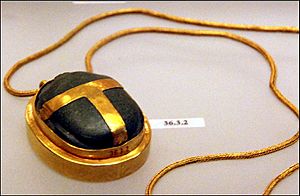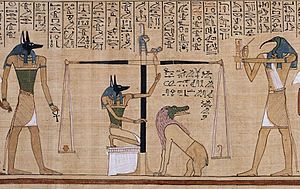Ancient Egyptian conception of the soul facts for kids
The ancient Egyptians believed that a person's soul was made of many different parts. They thought these parts worked together to make a complete person. Besides the soul, there was also the human body itself.
According to ancient Egyptian stories, the god Atum created the world using his own magic. Because of this, Egyptians believed that magic was everywhere, even in living things. When humans were created, this magic became their soul. The idea of the soul and its parts changed over time. But most ancient Egyptian writings about death mention several parts of the soul:
- Khet or the "physical body"
- Sah or the "spiritual body"
- Ren or the "name, identity"
- Ba or the "personality"
- Ka or the "double" or "vital essence"
- Ib or the "heart"
- Shut or the "shadow"
- Sekhem or the "power, form"
After a person died and successfully passed into the afterlife, all these parts together were called the Akh. An expert named R. David explains that Egyptians believed a person had many sides. In life, a person was whole. But after death, if they lived a good life, they could use different forms in the next world. These forms could help friends or even get revenge on enemies.
Contents
The Khet (Physical Body)
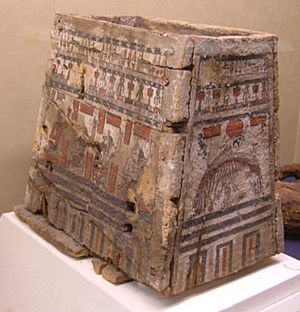
The Khet was the physical body. It was very important for the soul to have a body. This body allowed the soul to think and be judged in the underworld. So, Egyptians needed to preserve the body as well as possible. They also made burial chambers special with paintings and statues. These showed important moments from the person's life.
At first, only pharaohs were mummified. This gave them a chance for an eternal afterlife. Later, by the Middle Kingdom, everyone could be mummified. A Greek historian named Herodotus saw this. He noted that families could choose how much they wanted to spend on mummification.
Because the body's condition was so important for the afterlife, tombs were decorated. They showed the dead person's favorite activities. Small statues called ushabtis were also placed in tombs. These were like servants, slaves, or guards. Sometimes even beloved pets were included. They were meant to serve the dead person in the afterlife.
Before a person could be judged, they had to be "awakened." This happened through special funeral ceremonies. These rituals were meant to bring the mummified body back to life in the afterlife. The most important ceremony was the opening of the mouth ceremony. This ritual was meant to reanimate each part of the body. This way, the spiritual body could move in the afterlife.
The Sah (Spiritual Body)
If all the rituals for the Khet were done correctly, the Sah would form. This happened if the dead person was found worthy by Osiris and the gods of the underworld. The Sah was the spiritual form of the physical body. This spiritual body could then interact with other beings in the afterlife.
The Sah was part of the larger Akh. Sometimes, the Sah was seen as a spirit that would return from the underworld. It would seek revenge on those who had wronged the person when they were alive. One famous example is a letter found in a tomb. A man wrote to his dead wife, who he believed was haunting him. He asked what bad thing he had done to her. He explained how he had cared for her when she was sick. He also said he had mourned her deeply.
The Ren (Name, Identity)
A person's name, or Ren, was a very important part of who they were. It was also key to their survival after death. Most ancient Egyptian names had a special meaning. This meaning was thought to be directly connected to the person.
Putting a name on a statue meant that the statue belonged to the dead person. It gave them a second body. If a name was removed from an object, it broke this connection. Sometimes, this was done on purpose to stop someone from having a good afterlife.
The Ba (Personality)
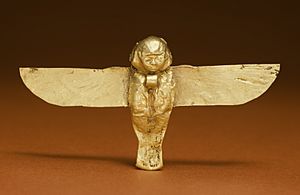
The Ba was everything that made a person unique. It was like their personality. Even objects could have a Ba, meaning a unique character. For example, ancient pyramids were sometimes called the Ba of their owner.
Egyptians believed the Ba would live on after the body died. It is often shown as a human-headed bird. This bird would fly out of the tomb to join with the Ka in the afterlife. In some ancient texts, the Ba could even eat and drink after death.
One expert, Louis Vico Žabkar, says the Ba was not just a part of the person. He believes it was the person themselves. This is different from how many other religions see the soul. The idea of a soul without a body was very strange to Egyptians. When Christianity came to Egypt, they used a Greek word for "soul" instead of Ba. This shows how special the Ba concept was to ancient Egyptian thinking.
The Ba of the dead person is also shown in the Book of the Dead. It returns to the mummy and takes part in life outside the tomb. This is like the sun god Ra joining with Osiris each night.
The word Baw was the plural of Ba. It meant "impressiveness" or "power," especially for a god. When a god helped humans, it was said that the god's Baw was at work.
The Ka (Vital Essence)
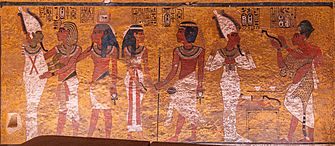
The Ka was the Egyptian idea of a vital essence. It was what made the difference between a living and a dead person. Death happened when the Ka left the body. Egyptians believed that the god Khnum created children's bodies on a potter's wheel. Then he put them into their mothers' bodies.
Depending on the area, Egyptians thought that Heqet or Meskhenet created each person's Ka. They breathed it into them at birth. This was the part of their soul that made them alive. It is similar to the idea of a "spirit" in other religions.
Egyptians also believed that the Ka needed food and drink to survive. So, they offered food and drinks to the dead. But it was the Ka inside the offerings that was eaten, not the physical food. In the Middle Kingdom, special offering trays called soul houses were made for this. The Ka was often shown as a second image of the king. This led some people to think Ka meant "double."
In old tombs, artwork showed a "double world." This world had important people and objects for the Ka of the tomb owner. Expert Andrey Bolshakov explains that the Ka was a very important idea for the afterlife in the Old Kingdom. It became less important later, but the Ka always received offerings.
The Ib (Heart)
An important part of the Egyptian soul was the Ib, or heart. In Egyptian religion, the heart was the key to the afterlife. It was needed to survive death in the underworld. There, it would speak for or against its owner.
Like the physical body, the heart was necessary for judgment in the afterlife. It had to be carefully preserved inside the mummified body. A heart scarab was placed over it. This was to stop the heart from telling bad tales about the person. According to the Books of Breathing, a text for the dead:
- The Book of Breathings, made by Isis, is placed under the left arm near the heart.
It was believed that the heart was examined by Anubis and other gods. This happened during the Weighing of the Heart ceremony. If the heart weighed more than the feather of Maat (truth), it was eaten by the monster Ammit. Then the soul would never find peace.
The Shut (Shadow)
A person's shadow, or Shut, is always there. Because of this, Egyptians thought a shadow held something of the person it belonged to. Statues of people and gods were sometimes called shadows.
An expert named Ogden Goelet, Jr. talks about the forms of the shadow. In many ancient papyri and tombs, the dead person is shown coming out of the tomb as a shadow. It is a thin, black shape of a person. This means the person is just a shadow of their past self, but still exists. Another form the shadow takes, especially with gods, is an ostrich-feather sun-shade. This object would create a shadow.
The Sekhem (Power, Form)
Not much is known about what Egyptians thought of this part of the soul. Many experts say Sekhem was the living force of the soul. It exists in the afterlife after all judgment has happened. In the Book of the Dead, it is called "power." It is also described as a place where Horus and Osiris live in the underworld.
The Akh (Intellect)
The Akh was a concept of the dead that changed over time in ancient Egypt. In relation to the afterlife, the Akh meant the dead person who had been transformed. It was often linked to light.
The Akh was connected to thought, but not just as a mind's action. It was like intellect as a living being. The Akh also had a role in the afterlife. After the physical body died, the Ba and Ka would reunite. This would bring the Akh back to life.
Bringing the Akh back was only possible if the right funeral rituals were done. Also, offerings had to be made regularly. This ritual was called "making a dead person into a living Akh." Later, during the Twentieth Dynasty, the Akh could become a kind of roaming ghost. This happened if the tomb was not kept in order.
An Akh could do good or harm to living people. It could cause nightmares, guilt, or sickness. People could ask for help from an Akh through prayers or letters left in the tomb. This was to help living family members. For example, an Akh could help with arguments. It could also ask other dead people or gods to make things better on Earth. But it could also cause punishments.
The Akh was formed when the Ka and Ba reunited after death. This needed the right offerings and knowing the correct spells. But there was a risk of dying again. Egyptian funeral texts, like the Coffin Texts and the Book of the Dead, helped the dead "not die a second time." They also helped them become an Akh.
Relationships of the Soul Parts
Ancient Egyptians believed that death happened when a person's Ka left the body. Priests performed ceremonies after death. One was the "opening of the mouth." These rituals aimed to bring back a person's physical abilities in death. They also helped the Ba let go of its attachment to the body. This allowed the Ba to join with the Ka in the afterlife. When they joined, they created an entity called an Akh.
Egyptians imagined the afterlife as quite similar to normal life. But it had a difference. The journey of the Sun was a model for this new existence. At night, the Sun went down into the underworld. Eventually, the Sun met the mummified body of Osiris. Osiris and the Sun, energized by each other, would rise to new life for another day.
For the dead person, their body and tomb were their own Osiris and underworld. So, they were often called "Osiris." For this process to work, some kind of body preservation was needed. This allowed the Ba to return during the night. It could then rise to new life in the morning. The complete Akhs were also thought to appear as stars. For a long time, only royals expected to join with the Sun god.
The Book of the Dead was a collection of spells. It helped a person in the afterlife. Its Egyptian name meant "Book of going forth by day." These spells helped people avoid dangers in the afterlife. They also helped them exist. The spells included ways to "not die a second time in the underworld." They also aimed to "grant memory always" to a person. In Egyptian religion, it was possible to die in the afterlife. This second death was permanent.
The tomb of Paheri, a ruler from the Eighteenth Dynasty, has a clear description of this existence. It says:
Your life happening again, without your ba being kept away from your divine corpse, with your ba being together with the akh ... You shall emerge each day and return each evening. A lamp will be lit for you in the night until the sunlight shines forth on your breast. You shall be told: "Welcome, welcome, into this your house of the living!"
See also
 In Spanish: Componentes del ser humano en el Antiguo Egipto para niños
In Spanish: Componentes del ser humano en el Antiguo Egipto para niños
- Soul dualism, similar beliefs in other traditions.
- The Ti bon ange and the Gros bon ange in Haitian Vodou; Soul dualism in Haitian Vodou.


